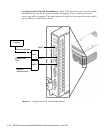
1-8 SPARC Enterprise M4000/M5000 Servers Site Planning Guide • April 2007
1.2.2.2 Space for Thermal Clearance
Both midrange servers must maintain the minimum thermal distance between the
rear of the server in an equipment rack, and any obstructions or walls. For thermal
clearance requirements during operation, refer to the SPARC Enterprise Equipment
Rack Mounting Guide.
1.2.3 Access Route
If your existing loading dock meets height or ramp requirements for a standard
freight carrier truck, you can use a pallet jack to unload the server. If not, you must
provide a standard forklift or other means to unload the server, or request the server
be shipped in a truck with a lift gate.
All servers not shipped in an equipment rack should be lifted only by proper
computer-lifting equipment to prevent personal injury or damage to system
equipment.
Each server that is not preinstalled in an equipment rack is shipped in a separate
crate. A pallet jack is required to move each shipping crate to the server location.
Leave each server in its shipping crate until it reaches its final destination. If the
crate does not fit through the planned access route, partially disassemble it.
The entire access route to your computer room should be free of raised patterns that
can cause vibration. The route must meet the following requirements:
■ Minimum door height
■ Minimum elevator depth
■ Maximum incline of 10 degrees
■ Minimum elevator, pallet jack, and floor loading capacity
Refer to the SPARC Enterprise Equipment Rack Mounting Guide for specific
requirements for your equipment rack.
1.2.4 Stabilizing the Rack
Equipment racks can be permanently mounted to the floor. For more information on
stabilizing the equipment rack, refer to the SPARC Enterprise Equipment Rack
Mounting Guide.


















